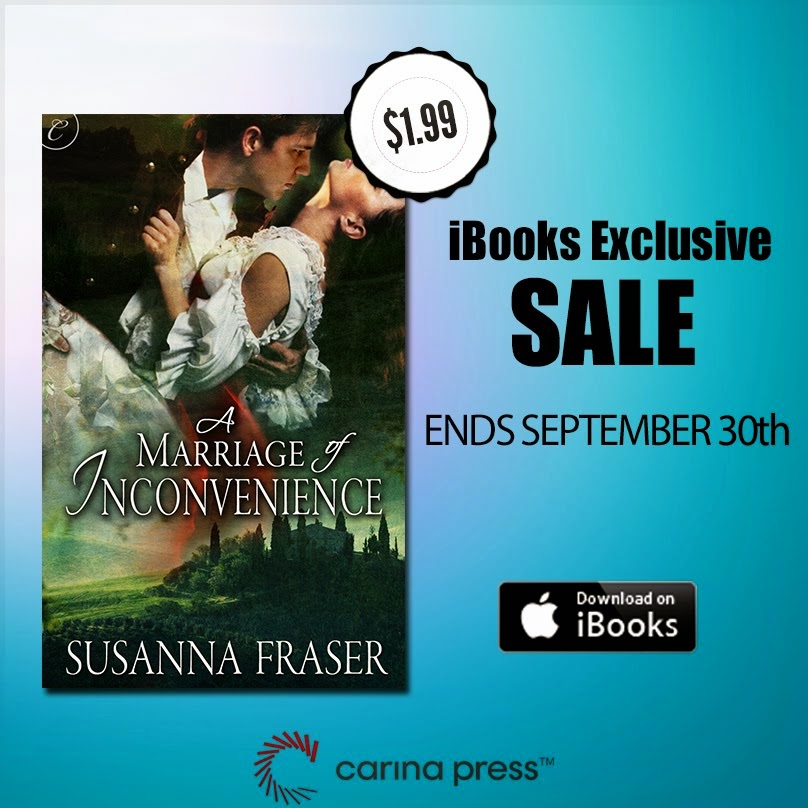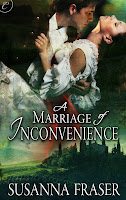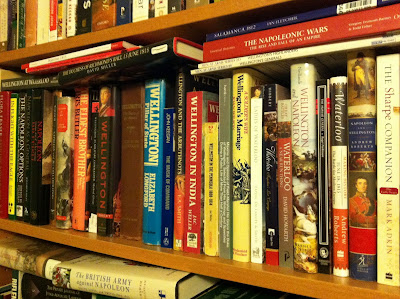
“…this was a very enjoyable, mildly angsty romance with just a tiny hint of kink.”
The Romanceaholic
“it’s steamy and defiantly gives you the chills with how much detail is given. James is very much the tall dark and handsome man that you want to read about.”
1. Tell us about A Marriage of Inconvenience. Is it connected to The Sergeant’s Lady (which I loved!)?
Yes, it’s a prequel. The hero, James, is the brother of Anna, the heroine of The Sergeant’s Lady, and the heroine, Lucy, is a poor relation of Sebastian, Anna’s first husband.
Lucy Jones is a nobody. As an orphan she was reluctantly taken in by her wealthy relatives, the Arringtons, on the condition that she be silent and obedient, always. When her lifelong infatuation with her cousin Sebastian is rewarded by a proposal of marriage, she’s happy and grateful, even though the family finds excuses to keep the engagement a secret.
James Wright-Gordon has always had the benefits of money and a high station in society, but he is no snob. He’s very close to his sister, Anna, who quickly falls for the dashing Sebastian when the families are brought together at a wedding party. Meanwhile, James is struck by Lucy’s quiet intelligence, and drawn to her despite their different circumstances in life.
Lucy suspects that Sebastian has fallen for Anna, but before she can set him free, a terrible secret is revealed that shakes both families. Will James come to her rescue—or abandon her to poverty?
2. What sparked the idea for A Marriage of Inconvenience?
It got its start as a Mansfield Park adaptation, believe it or not. I saw the 1999 version a couple years after it came out, and for the next day all I could do was talk to my husband about how I would adapt Mansfield Park. Instead of changing Fanny’s character to be more palatable for a modern audience, I wanted to go inside her head and show a modern audience what would make a naturally spirited and intelligent woman act as meek and yielding as Fanny.
This was before I’d ever completed a manuscript. I started them all the time, but I would get three or four chapters in and then get bored and quit. By the time I got this idea, I’d given up thinking I’d ever finish a book. But weeks went by, and I couldn’t stop thinking about how I would adapt Mansfield Park. Eventually I started writing, thinking that I would get bored soon and give up. That never happened. Since I was a writer and not a filmmaker, I knew I couldn’t use Austen’s exact characters and plot unless I wanted it to be fanfic. So I started making changes.
The most obvious change was to make the Henry Crawford figure the hero. So I gave him more integrity than Henry, but he was still the type of man a sheltered, innocent girl would think of as an intimidating rake. I made what turned out to be a fateful decision to make the Edmund Bertram figure, Sebastian, an officer instead of a clergyman. The more I wrote, the more the story changed, but when I finished the very first draft of the book in 2003, its Mansfield Park roots still showed.
I was shocked that I had finished a whole book. Not for the world would I show anyone that version of the manuscript now. It was 150,000 words long. It rambled. It was written in first person from the heroine’s point of view. Nevertheless, I did send the book to a few agents. It got soundly rejected.
 One of the ways my story had drifted away from its roots was that my Mary Crawford placeholder character, Anna, had grown on me as I wrote. And Sebastian had turned out far more villainous than Edmund Bertram ever thought about being on his worst day. (Edmund is by far my least favorite of Austen’s heroes, but compared to Sebastian Arrington, he’s a paragon.) So I knew I needed to tell Anna’s story and give her a chance to find someone worthy of her. Since I’d made Sebastian a soldier during a war, he was wonderfully easy to kill off. And that’s how The Sergeant’s Lady came to be.
One of the ways my story had drifted away from its roots was that my Mary Crawford placeholder character, Anna, had grown on me as I wrote. And Sebastian had turned out far more villainous than Edmund Bertram ever thought about being on his worst day. (Edmund is by far my least favorite of Austen’s heroes, but compared to Sebastian Arrington, he’s a paragon.) So I knew I needed to tell Anna’s story and give her a chance to find someone worthy of her. Since I’d made Sebastian a soldier during a war, he was wonderfully easy to kill off. And that’s how The Sergeant’s Lady came to be.
After I finished The Sergeant’s Lady, I decided to revisit James and Lucy’s story. I added additional points of view and started thinking of it as these characters’ story rather than my dialogue with Mansfield Park. The story turned out so different from my original concept that I don’t think of it as my first manuscript anymore. It’s my third manuscript, which just happens to be loosely based on my first one.
3. What is risky about A Marriage Of Inconvenience?
Quite a few things. For starters, James is short. I never explicitly state his height in the book, but I’ll do so now: he’s 5’6”. (He’s still half a foot taller than Lucy, though. One of these days I’ll get really daring and write a romance where the heroine is taller than the hero.) Also, James and Lucy are quite a young couple by current romance standards–James is 24 and Lucy, 18.
Another risk I took was to show the development of Anna and Sebastian’s marriage and how it went wrong. It’s integral to the story and has a major impact on Lucy and James’s growing relationship, but usually romances with a secondary couple use that couple for light comic relief rather than as a source of darkness and angst. I’m hoping that readers will forgive me once they discover that there is a sequel out there. And I did make sure to mention in the epilogue that Sebastian is dead and Anna is happy with someone else.
Last but far from least, James and Lucy don’t find instant sexual bliss after they marry. Lucy has certain mental blocks about letting go and experiencing pleasure, and the solution they discover takes them into somewhat kinky territory.
4. Did you come across any interesting research tidbits while writing the
book?
I had a lot of fun planning the setting. I found a book called Life in the English Country House, by Mark Girouard–which, incidentally, I highly recommend to anyone researching the era–and I enjoyed contrasting families with old titles who lived in ancient piles with James’s new money and the playful, whimsical castle his father had built.
5. What is next for you?
That is a vexed question. I’m coming out of a five-month battle with carpal tunnel syndrome, which has unfortunately slowed my writing process. I don’t have any other books currently under contract, but I’m working on a novella set during the Peninsular War where both the hero and heroine are common, as well as a Napoleonic-era historical fantasy that I hope will be the first of a series. The heroine’s unusual background and paranormal abilities lead to her becoming the only woman officer in Wellington’s army. I’ve often said that every historical author has a chick-in-pants story somewhere in her imagination, and this is mine.
Fortunately my hand is finally starting to heal, and I’m learning to use DragonDictate so I can keep writing even when my wrists won’t cooperate. I’ve written this post using Dragon, as a matter of fact. So with any luck, my new stories will be finished soon and I can start finding homes for them.
6. Tell us how to purchase A Marriage of Inconvenience.
It’s only available electronically. You can buy it direct from the publisher, Carina Press, from Amazon, from Barnes & Noble, from Apple’s iBooks store, etc.––really, most anywhere e-books are sold.
If you are trying an e-book for the first time, I recommend making it easy on yourself. If you don’t have an e-reader, you can read e-books on your computer or your smartphone. Amazon and Barnes & Noble offer free versions of the Kindle and Nook apps you can download onto your computer, iPad, or phone. Once you’ve done that, it’s a straightforward process to purchase books from their sites and read on your device of choice.
And now I have some questions for you. Writers, have you ever used a classic story as inspiration? Readers, are there stories you’d like to see your favorite authors adapt? One commenter will win a free download of A Marriage of Inconvenience.






.jpg)

